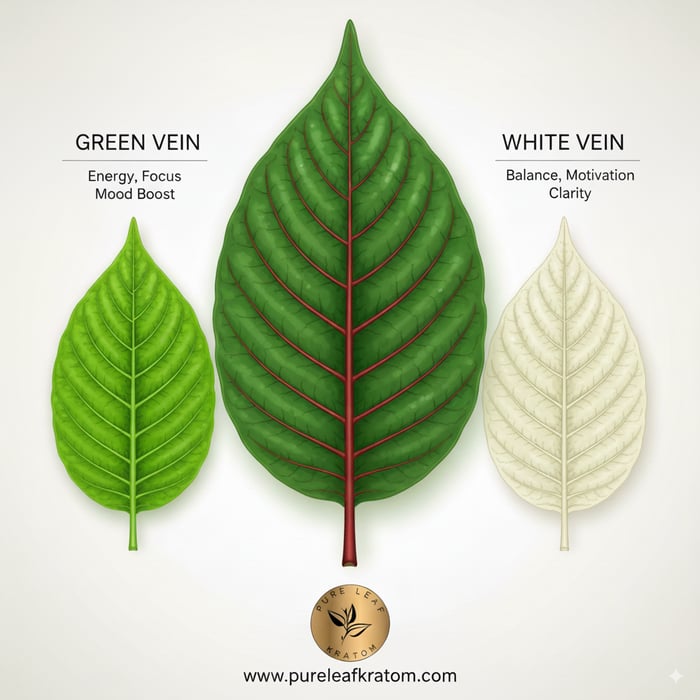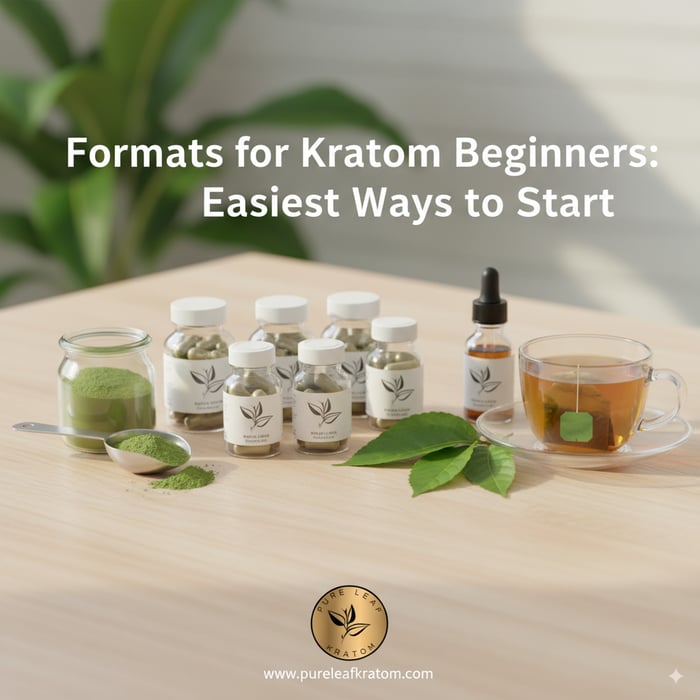
Kratom Leaf Anatomy: Colors, Veins, and What They Mean
Table of Contents
- Introduction: Looking Beyond the Leaf
- 1. The Basic Structure of a Kratom Leaf
- 2. Colors of Kratom Leaves
- 3. Rare and Exotic Leaf Variations
- 4. The Role of Veins in Leaf Anatomy
- 5. Shapes and Sizes of Kratom Leaves
- 6. What Leaf Characteristics Reveal
- 7. Kratom Leaves and Their Cultural Significance
- 8. Leaf Anatomy in Cultivation and Harvesting
- 9. The Beauty of Kratom Leaves
- 10. Looking Ahead: The Future of Kratom Research
- FAQs
Introduction: Looking Beyond the Leaf
Kratom has fascinated enthusiasts for centuries, not only for its origins and traditions but also for its distinct appearance. While many people focus on products derived from the plant, fewer take the time to appreciate the anatomy of the leaf itself. Every kratom leaf tells a story its size, shape, vein color, and even subtle details like its edge patterns hold meaning. These small differences are more than cosmetic; they reflect the environment where the tree grew, the soil it drew its nutrients from, and the way it was harvested and prepared.
Looking closely, the kratom leaf becomes less of a simple plant part and more of a natural record of its journey. Its wide, oval body with pointed tips and symmetrical venation has evolved to capture maximum sunlight in the dense Southeast Asian jungles, where tall canopies compete for every ray of light. The glossy green surface protects against excessive evaporation, while its sturdy veins serve as a roadmap of the leaf’s development. Even the serrated or smooth edges vary, hinting at subtle genetic differences across regional strains.
Understanding the anatomy of the kratom leaf is about more than identifying strains; it provides insight into cultivation, harvesting, and the traditions that shaped its role across cultures. Farmers in different regions of Thailand, Indonesia, and Malaysia have long recognized the significance of leaf characteristics, using vein color and leaf shape as natural indicators of maturity. What may look like a small detail to the casual observer becomes a marker of quality, readiness, and tradition to the experienced harvester.
In this blog, we’ll explore the science, beauty, and significance of kratom leaves focusing on colors, veins, and what these characteristics reveal. By the end, you’ll see that the kratom leaf itself isn’t just a raw material for products it’s a living symbol of nature’s precision and cultural heritage.
1. The Basic Structure of a Kratom Leaf
Before diving into colors and veins, it helps to start with the fundamentals. Like all leaves, kratom leaves are built from a few essential parts, but what makes them special is the way these features work together to support the plant’s growth and reflect its environment.
Blade (Laminate): The blade is the broad, flat surface where photosynthesis takes place, capturing sunlight and converting it into energy for the tree. Kratom blades are usually oval with a distinct taper toward the tip, though their size can vary widely depending on the age of the tree, the season, and growing conditions. In dense forests, broader leaves often form to catch scarce light, while leaves grown in open spaces may appear slimmer and more uniform.
Veins: The network of veins branching through the blade acts like the leaf’s circulatory system. These channels transport water, minerals, and nutrients, while also reinforcing the structure so the leaf can withstand wind, rain, and the weight of dew. The vein patterns themselves are what give kratom leaves their most recognized distinctions, forming the foundation for the well-known red, green, and white categories.
Petiole: The petiole is the short stalk that anchors the leaf to its branch. Though small, it serves as the critical connection point, carrying nutrients from the tree into the blade and returning the sugars produced during photosynthesis back to the plant. In kratom, the petiole is usually sturdy, reflecting the leaf’s need to stay firmly attached in the humid, storm-prone regions where the trees thrive.
Margin: The edge, or margin, of the leaf tends to be smooth, but subtle variations can occur. Some leaves show faint ridges or slight serrations, a detail often overlooked but one that highlights the natural diversity within kratom trees. Farmers sometimes use margin differences as small indicators of a tree’s genetic lineage.
Apex: The leaf’s apex is its pointed tip, a sleek feature that gives kratom leaves their distinctive tapered shape. This design isn’t just aesthetic it helps water run off efficiently during heavy rains, reducing the risk of fungal buildup in the tropical climates where the plant grows.
While kratom leaves share the same basic structure as countless other plants, it’s their subtle differences the blade’s sheen, the vein patterns, and the way the apex narrows that make them so unique. These features serve as the foundation for understanding why leaf colors and vein systems matter, setting the stage for a deeper look at what makes each type of kratom leaf stand out.
2. Colors of Kratom Leaves
When kratom enthusiasts mention “red,” “green,” or “white,” they’re typically referring to the color of the leaf’s veins. However, the blade itself also carries a variety of shades ranging from deep emerald to pale olive depending on the leaf’s age, the amount of sunlight it receives, and the nutrients absorbed from the soil. This interplay of blade and vein coloration is what gives kratom its unique identity, both visually and symbolically.
Let’s break down the most recognized vein categories:
Red Vein Leaves
Appearance: Red vein kratom leaves are marked by veins that take on shades ranging from soft reddish hues to deeper maroon streaks. Against the green backdrop of the blade, these veins often stand out vividly, making them among the easiest to identify. In some cases, the entire leaf may appear slightly darker overall, as if the red pigments subtly influence the green of the blade.
Harvesting Stage: Red veins are most commonly linked to mature leaves. As the leaf ages, shifts in pigmentation begin to take place, often due to sunlight exposure and environmental factors such as humidity and soil composition. Farmers who have cultivated kratom for generations use these subtle changes as a natural marker of readiness, recognizing that a leaf’s vein color tells a story about its growth cycle.
Symbolism: Across many cultures, the color red is tied to strength, vitality, and endurance. In the context of kratom, red vein leaves have become symbolic of maturity, balance, and depth. They represent a fully developed stage of the leaf’s life and are often associated with stability
Green Vein Leaves
When kratom enthusiasts mention “red,” “green,” or “white,” they’re typically referring to the color of the leaf’s veins. However, the blade itself also carries a variety of shades ranging from deep emerald to pale olive depending on the leaf’s age, the amount of sunlight it receives, and the nutrients absorbed from the soil. This interplay of blade and vein coloration is what gives kratom its unique identity, both visually and symbolically.
Let’s break down the most recognized vein categories:
Red Vein Leaves
Appearance: Red vein kratom leaves are marked by veins that take on shades ranging from soft reddish hues to deeper maroon streaks. Against the green backdrop of the blade, these veins often stand out vividly, making them among the easiest to identify. In some cases, the entire leaf may appear slightly darker overall, as if the red pigments subtly influence the green of the blade.
Harvesting Stage: Red veins are most commonly linked to mature leaves. As the leaf ages, shifts in pigmentation begin to take place, often due to sunlight exposure and environmental factors such as humidity and soil composition. Farmers who have cultivated kratom for generations use these subtle changes as a natural marker of readiness, recognizing that a leaf’s vein color tells a story about its growth cycle.
Symbolism: Across many cultures, the color red is tied to strength, vitality, and endurance. In the context of kratom, red vein leaves have become symbolic of maturity, balance, and depth. They represent a fully developed stage of the leaf’s life and are often associated with stability and groundedness.
Appearance: Easily identified by their bright or forest-green veins.
Harvesting Stage: Green veins are generally found in leaves that are neither the youngest nor the most mature sitting right in the middle of the growth cycle.
Symbolism: Green often symbolizes balance and harmony. In kratom terms, it represents a middle ground between the other vein colors.
White Vein Leaves
Appearance: These leaves have pale, whitish or light-colored veins.
Harvesting Stage: White vein leaves are often younger and less mature than red or green. Their brightness comes from early-stage growth and lighter pigmentation.
Symbolism: White vein leaves are tied to freshness and energy, making them popular among enthusiasts who like a “lighter” option.
3. Rare and Exotic Leaf Variations
While red, green, and white are the most common categories, enthusiasts sometimes encounter rare hues:
Yellow Vein Kratom: Usually a result of specialized drying or fermentation techniques rather than a naturally occurring vein color. Yellow leaves are often described as having unique qualities compared to the three primary colors.
Gold Kratom: Like yellow, this variation typically comes from post-harvest processing rather than natural leaf pigmentation.
Dark Greens or Multi-Colored Veins: Occasionally, leaves can display multiple shades, reflecting unusual growing conditions or cross-regional cultivation.
These rare categories highlight the creativity of cultivators and how traditional processing methods have expanded the diversity of kratom products.
4. The Role of Veins in Leaf Anatomy
Veins are more than just colorful patterns they’re essential to the survival of the plant. Here’s what they do:
Transport System: Veins move water, nutrients, and energy throughout the leaf.
Structural Support: They act like a skeleton, holding the blade’s shape and preventing tearing.
Identification Markers: Farmers often rely on vein color and arrangement to determine when to harvest and how to process.
Vein Patterns in Kratom
Kratom leaves display a classic pinnate venation pattern, where smaller veins branch out gracefully from a single central vein, or midrib, much like the delicate structure of a feather. This pattern is not only visually striking giving the kratom leaf a sense of symmetry and natural elegance but also highly functional. The branching veins help distribute nutrients and water throughout the leaf efficiently, while their arrangement allows sunlight to reach each part of the kratom leaf evenly, maximizing photosynthesis. At the same time, the central midrib provides structural stability, helping the leaf maintain its shape as it sways in tropical winds. In essence, the pinnate venation of kratom leaves is a perfect blend of artistry and engineering, reflecting both the beauty and ingenuity of nature.
5. Shapes and Sizes of Kratom Leaves
Another overlooked feature of kratom anatomy is the shape of its leaves. While vein color often steals the spotlight, enthusiasts can appreciate how much variety exists in size and outline.
Shape: Kratom leaves are generally oval or elliptical, with pointed tips. Some leaves curve slightly, while others are perfectly symmetrical.
Size: Mature kratom leaves can grow quite large up to 7–8 inches in length. Younger leaves are smaller, tender, and often brighter in color.
Texture: The surface of the leaf tends to be smooth with a waxy sheen, which helps repel water during heavy rainfall in tropical regions.
The combination of size, shape, and vein coloration creates a natural fingerprint for every kratom leaf.
6. What Leaf Characteristics Reveal
So, what do these features really mean for kratom enthusiasts? While vein color and shape don’t change the plant’s essence entirely, they do provide clues about:
Harvest Timing: The maturity of a leaf often corresponds with its vein color.
Processing Style: Some vein colors, especially yellow or gold, may indicate special drying or fermentation techniques.
Regional Identity: The appearance of kratom leaves can reflect the soil, climate, and cultivation practices of their origin.
In other words, colors and veins aren’t just cosmetic they’re part of kratom’s identity.
7. Kratom Leaves and Their Cultural Significance
In Southeast Asia, where kratom originates, the kratom leaf’s anatomy has long been recognized by farmers and communities. Villagers historically distinguished between leaves based on color and maturity, tailoring their uses accordingly.
Local knowledge often connected vein colors with symbolic qualities:
Red: Strength, endurance, and resilience.
Green: Balance, growth, and connection to nature.
White: Freshness, clarity, and renewal.
This cultural perspective continues to influence how kratom is categorized and marketed today.
8. Leaf Anatomy in Cultivation and Harvesting
For cultivators, paying attention to vein colors and leaf development is essential. The anatomy guides important steps like:
Determining When to Pick: Mature leaves often carry different vein colors than young ones, signaling readiness.
Sorting After Harvest: Leaves are grouped by vein color for consistency.
Processing Techniques: Drying in sunlight, shade, or through fermentation affects how the veins look, sometimes transforming green into yellow or gold.
This careful attention ensures that kratom products align with the expectations of enthusiasts worldwide.
9. The Beauty of Kratom Leaves
Beyond their practical use, kratom leaves are strikingly beautiful in ways that often go unnoticed at first glance. Their glossy surfaces catch the light, highlighting a network of vibrant veins that weave across each blade like threads of living art. No two leaves are exactly alike some boast deep emerald veins against lighter green backgrounds, while others display subtle gradients of olive, jade, or even hints of gold. These variations tell the story of each leaf’s growth, the sunlight it absorbed, and the nutrients it drew from the soil.
The symmetry of a kratom leaf adds to its visual appeal. From the central vein, smaller veins branch outward with remarkable precision, creating patterns that are both functional and aesthetically pleasing. Enthusiasts often describe holding a kratom leaf as an experience in itself: it’s a chance to connect with nature, to observe the intricate details of a plant that has been cultivated and revered for centuries. In many ways, the journey of appreciating kratom begins not with the powdered leaf in a capsule or extract, but with taking a moment to admire the living leaf in its natural form. It is a reminder that beauty and complexity coexist in even the simplest elements of the natural world.
10. Looking Ahead: The Future of Kratom Research
As kratom continues to gain attention around the world, both researchers and cultivators are increasingly focused on understanding the finer details of leaf anatomy. Future studies may uncover previously unseen vein patterns, new hybrids, and subtle differences influenced by geography, soil composition, and climate. These discoveries will not only enrich scientific understanding but will also inform cultivation practices and product development, allowing enthusiasts to explore a broader spectrum of leaf characteristics.
Innovation in cultivation and processing is also on the horizon. Expect new strains to emerge, each with distinctive colors, shapes, and vein structures that expand the story kratom leaves have been telling for centuries. Processing methods may evolve as well, highlighting the visual and textural qualities of the leaf in ways that were previously overlooked. For kratom enthusiasts, this means more than new products it’s an invitation to deepen appreciation for a plant that is as complex and dynamic as the regions in which it thrives. The future of kratom is not just about broader access or variety; it’s about celebrating and exploring the intricate natural artistry found in every leaf.
Conclusion: More Than Meets the Eye
Kratom leaf anatomy is a fascinating subject that goes far beyond the familiar categories of red, green, and white veins. Each leaf is like a natural blueprint, carrying subtle details that tell a story about its maturity, the conditions it grew in, the way it was harvested, and even the traditions tied to its use. From the texture of the blade to the branching of the veins, kratom leaves reveal a complexity that reflects the richness of the tropical landscapes they come from.
The surface of a kratom leaf isn’t just smooth and glossy it’s alive with patterns that shift under sunlight, showcasing shades of emerald, jade, or olive depending on age and soil nutrients. The central vein acts as the backbone, with smaller veins spreading outward in symmetrical lines, guiding nutrients through the leaf much like rivers feed a landscape. These veins not only determine the leaf’s coloration but also symbolize the delicate balance between nature’s design and human interpretation.
When you hold a kratom leaf whether fresh, dried, or powdered you’re holding a fragment of a much larger story. Each one has spent months capturing sunlight, pulling minerals from the earth, and swaying in humid tropical winds. It has absorbed the rhythms of its environment, carrying the imprint of centuries-old cultivation practices and cultural traditions. To many, the leaf is more than just a product; it’s a reminder of the relationship between people and the natural world.
So, the next time you come across a kratom product, pause for a moment to think about its origin. Behind every capsule, tablet, or powder lies a leaf that once thrived under a broad green canopy, stretching toward the sun in a humid rainforest. Each leaf was shaped not only by the soil it grew in, but also by the rains that nourished it, the sun that strengthened it, and the hands that carefully harvested it. Its journey from seed to mature leaf is a quiet testimony to patience, balance, and respect for the natural cycle.
The colors and veins you see in kratom are more than visual markers. They are living evidence of nature’s artistry delicate streaks of red, green, or white etched across the surface like brushstrokes on a canvas. They are also symbols of cultural heritage, reflecting centuries of local knowledge passed down through farming traditions. Every vein pattern tells a small story about where the leaf grew, when it was picked, and how it was handled with care before reaching you.
To appreciate kratom fully is to see beyond the product itself and recognize the life within each leaf. It is to notice the artistry of its design, the heritage carried in its veins, and the connection it creates between distant landscapes and modern communities. Kratom’s anatomy its shapes, colors, and veins reminds us that even the smallest details in nature can hold a profound meaning, one that continues to inspire curiosity, respect, and tradition across generations.
FAQs
1. What do the different kratom vein colors mean?
Vein colors—red, green, and white—represent stages of leaf maturity and natural pigmentation. Red veins usually indicate mature leaves, green veins are mid-growth, and white veins often come from younger leaves.
2. Are yellow and gold kratom leaves natural?
Not exactly. Yellow and gold variations usually result from unique drying or fermentation techniques after harvest rather than natural vein pigmentation.
3. Why do kratom leaves have different shapes and sizes?
Leaf shape and size are influenced by age, sunlight exposure, soil nutrients, and regional growing conditions. Mature leaves can grow up to 7–8 inches, while younger ones are smaller and brighter in color.
4. Do the margins (edges) of kratom leaves matter?
Yes. While most kratom leaves have smooth margins, slight ridges or serrations can appear. These small details sometimes hint at genetic diversity among trees.
5. What is special about kratom vein patterns?
Kratom leaves feature a pinnate venation pattern, where veins branch from a central midrib like a feather. This design strengthens the leaf and maximizes photosynthesis efficiency.
6. Can vein color affect how kratom is processed?
Yes. Farmers often sort leaves by vein color during harvest. Different drying methods can even alter the color, such as turning green leaves into yellow or gold.
7. Do kratom leaves look the same across regions?
No. Leaves vary depending on geography, soil, and climate. For example, kratom from different regions in Indonesia, Thailand, or Malaysia may show subtle differences in vein color, blade shape, or size.
8. Why are kratom leaves considered culturally significant?
In Southeast Asia, vein colors have long been associated with symbolic meanings red with strength, green with balance, and white with renewal. These associations still influence how kratom is categorized today.
9. What makes kratom leaves visually unique?
Their glossy green surfaces, feather-like vein symmetry, and wide variety of shades from emerald to olive give kratom leaves a natural beauty that sets them apart.
10. Will future research discover more about kratom leaf anatomy?
Yes. Researchers and cultivators are studying new hybrids, vein variations, and cultivation methods. Future findings may reveal even more about how environment and processing shape the anatomy of kratom leaves.




